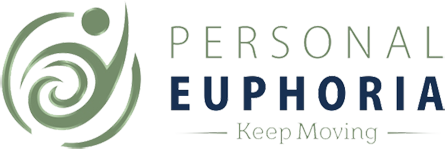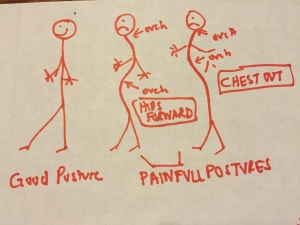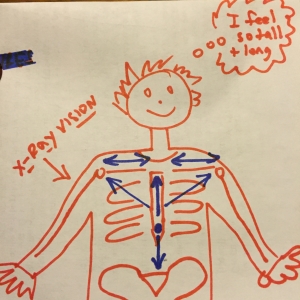Posture: 1. A position of a person’s body when standing or sitting. 2. A particular way of dealing with or considering something, an approach or an attitude.
When talking about the body, we tend to discuss definition number one—the actual physical position of our body. And while that’s important and does relate to our physical wellbeing, the second definition is directly linked to the first. Think of mopey Eeyore. He’s depressed and you can see it in his whole being. His body sags. His head slumps. He’s miserable, and you can tell before he even opens his mouth.
Yet walk into an interview or any stressful situation after assuming a power pose (think Super Woman) and studies show you will have more confidence and perform better. You can actually alter your hormones and the way you feel by changing your posture. Next time you have a big event go into a bathroom stall (where no one can see you) and make yourself larger than life—pushing your hands up to the ceiling and puffing your chest out or stand tall and firm with your hands on your hips for two minutes. Posture matters—for how your feel physically and emotionally. It also matters for how the world views you.
Remember when you were kid and you’d have a fight with your parents about the clothes you were wearing and what people would think? Dress as a Goth or a hippie and people will prejudge. Dress in a short skirt and people might prejudge. We can debate if that judgement it right or wrong, fair or appropriate, but it happens, and we know it does. If the clothes make the man, the posture makes the person.
Our posture is just like our clothes. It changes our attitude and the perceived attitude of those who encounter us throughout the day.
I tend to walk with my head down. It’s a postural issue. But it makes me look like I’m not confident. When I notice myself doing it, I’ll pick my head up, unless I’m having a moment where I don’t feel very confident, and then I often choose to leave my head down. So which comes first—the lack of confidence in that moment or my head being down? I’m not sure, but taking stock is helpful. Noticing is the first step to making any change.
So posture matters, but we have misconceptions about our posture and what makes good posture. Your posture can change from day-to-day and week-to-week. We may all have tendencies, but those can change quickly or over time. That doesn’t mean it doesn’t matter. We can use the term alignment instead of posture, but we are basically referring to the same thing.
What we need to consider is whether all our bones, joints and spaces lined up well with each other? Can you find a neutral place in your body where you feel comfortable, where basic movement like standing or walking becomes effortless? When we hear the word neutral we often think of the pelvis and low back, but all our joints have a neutral. And everyone’s neutral can be different.
When we picture perfect posture, Leonardo Di Vinci’s Vitruvian Man comes to mind. Oh, wait, did you think I was going to say Leonardo DiCaprio? When you think of perfect posture, your mind doesn’t immediately go to an ink drawing from the 15th century? The drawing is sometimes referred to as Proportions of Man. It’s the depiction of perfect proportions.
While Vitruvian Man may be perfect, I have yet to meet a person who is perfectly symmetrical. We are all a little longer, more crooked or slightly twisted on one side than the other. And I can’t even get inside your body to see if one of your organs is bigger or different or sitting somewhere else. I doubt we are supposed to force everyone into a perfectly square box or circle where they fit just so. Perfection is not our goal when thinking about posture. Comfort is the end goal. Poor posture leads to pain. If you can find a position that relieves you of pain, that is your good postural position.
So what are a few things you can think about to help improve your posture and get you out of pain? Consider the major landmarks of the body. Generally, our ankles, hips, ribs and head should all line up. If any of those parts are sticking out in front or back something is wrong.
Let’s focus on three of them:
Hips
One of the most common postures, known as a swayback, occurs when the pelvis swings forward, and to counterbalance that, so you don’t fall forward, the ribs swing back. If you are ever washing dishes or your hands and you noticing your pelvis is pushing into the sink or counter top, you probably have your hips too far forward. Try stacking your ribs and hips one on top of the other.
Ribs
Next, many of us tend to slouch forward—caving in at the ribs and rounding the shoulders forward. Then when we are told to have better posture we stick our chest out by shoving our ribs forward and squeezing our shoulder blades together. This definitely doesn’t create a sense of neutral anywhere in our spine or shoulders. Adjusting for the slouch in our upper backs is perhaps the hardest to correct properly.
Instead of sticking your chest out and your shoulders down, think of getting long from your tailbone to the crown of your head. Imagine creating space between each vertebra in your back. Get longer anywhere you can. To narrow it down to the ribs specifically, imagine your sternum (breastbone) getting longer. Instead of moving your breastbone forward, think of pulling the bottom of the breast bone down and the top up. It will not feel like a big move. Play with it because that will help your shoulders and back more than sticking your chest out. Once you feel like your breastbone is as long as it can get from end to end. Think of your collar bones getting longer.
Visualize and try to feel subtle movement in your body. Picture a dot in the center of your breast bone with arrow radiating our in all directions. So you get long from the both ends of the breast bone, but also you get long through an arrow going out of both shoulders like an upside down triangle—the top point at the base of your breastbone, the bottom corners at each shoulder and the base running along your collarbones. Think of the triangle being gently pulled from all three corners.
Head
Finally, our head usually sticks out forward of the rest of our body. We just need to think of pulling it back, but this can feel funny. Start with small moves. It doesn’t have to be all or nothing. Just because you read this today doesn’t mean that for the rest of your life you have to have your head in perfect alignment. It is always a balancing act, and trying to change too much too fast could cause other problems. So once in a while throughout your day, think of pulling your head back (see the turkey trot exercise) and holding it for as long as you can. You don’t have to pull the head so far back that it’s really uncomfortable. Start with a place you can hold it reasonably comfortably and build up.
While everything above considers misalignment from front to back, we can have poor posture from side-to-side. Do you ever catch yourself standing with one hip kicked out to the side? Is it always the same hip? Try shifting your weight into your other hip for a while. Try keeping equal weight on both feet with neither hip kicked out. This is a great exercise to practice whenever you get stuck in line somewhere. Play with the balance of your weight between your feet. Do you find parts of your body working harder than others? Do you feel tension anywhere? Is your butt or are your quads (front of the things) engaged or squeezing. Can you relax any muscles without falling over?
Play. The body is a big experiment, and it’s different every day. But if you want to get out of chronic pain, you need to check-in with how it’s feeling and what it is doing once in a while. Notice a habit and change or alter a habit to help yourself feel better.



[…] rib pop can wreak havoc on good posture. Click here to read […]
Dear Maggie,
Thank you for this post on managing rib pop! I didn’t know that was a thing. 🙂 I’m hyper flexible and can still do back ends & splits in my 50’s, but I’m developing round shoulders & turkey neck from years of bending forward as I help students. Argh! Your tips—infused with irreverent humor—strike me as just right! I look forward to reading more of your blog. A little personal euphoria never hurts. 🙂
Hi Kimberley,
Thanks for reading! I love talking about rib pop because I don’t think many people consider that when thinking of posture. Have a great day!
Hi Kimberley,
Thanks for reading. I love chatting about rib pop because I don’t think most people think about it with posture. We tend to think that rib pop is good posture. And if you are good at back bending your body may be happy in rib pop without realizing it. Just worth thinking about when we practice posture.